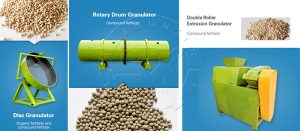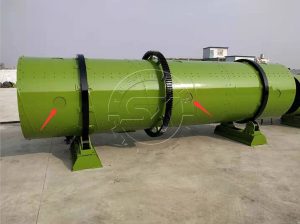Introduction
Fertilizers are fundamental to modern agriculture, enhancing plant growth and productivity by supplying essential nutrients. For example, it will provide nitrogen, phosphorus and potassium. As the demand for agricultural products escalates globally, the need for efficient and sustainable fertilizer production technologies becomes increasingly crucial. Enter double roller granulators, a pivotal innovation in the fertilizer industry, known for their efficiency and environmental benefits.
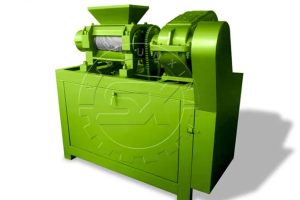
What is a Double Roller Granulator?
A double roller granulator is a type of machinery used in the dry granulation process, ideal for creating solid granules from powdered materials without requiring any liquid solution. This distinguishes it from other granulating technologies that often rely on wet granulation techniques involving binders and liquids. Key components of a double roller granulator include two counter-rotating rollers, a pressing mold (die), and a sophisticated driving mechanism—all engineered to produce high-quality granules. If you want to learn more, you can search my website: https://www.charbasedfertilizermachine.com/product/double-roller-extrusion-granulator/
How Double Roller Granulators Work?
The operation of a double roller granulator is a marvel of engineering precision, involving several critical steps:
- Material Feeding: Various powdered fertilizers containing nitrogen, phosphate, potassium, and other essential nutrients are fed into a hopper.
- Compression: These materials pass between two rollers that compress them under high pressure, forming a compact sheet.
- Granule Formation: The compressed sheets then break down into smaller, uniform granules.
- Output: Finally, the granules are collected, screened to ensure size uniformity, and packaged for distribution. The process utilizes a dry granulation method, which does not necessitate binders or additional liquid, making it environmentally friendly and efficient.
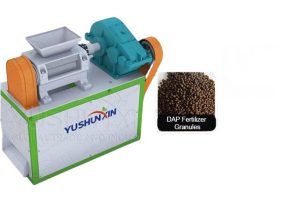
Benefits of Using Double Roller Granulators in Fertilizer Production
Double roller granulators offer multiple advantages:
- Efficiency: They provide high throughput with minimal waste, making the production process more streamlined.
- Energy Conservation: These machines consume less energy compared to those requiring wet granulation processes.
- Quality: The granulators ensure the production of high-density, uniform granules that promote even nutrient distribution in the field.
- Cost-Effectiveness: With low maintenance and operational costs, they are economically advantageous.
- Environmental Impact: The lack of water usage and wastewater production during the granulation process underscores its eco-friendly credentials.
Applications in the Fertilizer Industry
Double roller granulators are versatile, capable of processing various fertilizer formulations including NPK blends, urea, and ammonium sulfate. This adaptability allows manufacturers to meet diverse agricultural needs efficiently.
Certainly! Here’s a blog post crafted from your outline, focusing on the impact of double roller granulators in the fertilizer industry.
Enhancing Agricultural Productivity with Double Roller Granulators
Introduction
Fertilizers are fundamental to modern agriculture, enhancing plant growth and productivity by supplying essential nutrients. As the demand for agricultural products escalates globally, the need for efficient and sustainable fertilizer production technologies becomes increasingly crucial. Enter double roller granulators, a pivotal innovation in the fertilizer industry, known for their efficiency and environmental benefits.
What is a Double Roller Granulator?
A double roller granulator is a type of machinery used in the dry granulation process, ideal for creating solid granules from powdered materials without requiring any liquid solution. This distinguishes it from other granulating technologies that often rely on wet granulation techniques involving binders and liquids. Key components of a double roller granulator include two counter-rotating rollers, a pressing mold (die), and a sophisticated driving mechanism—all engineered to produce high-quality granules.
How Double Roller Granulators Work
The operation of a double roller granulator is a marvel of engineering precision, involving several critical steps:
- Material Feeding: Various powdered fertilizers containing nitrogen, phosphate, potassium, and other essential nutrients are fed into a hopper.
- Compression: These materials pass between two rollers that compress them under high pressure, forming a compact sheet.
- Granule Formation: The compressed sheets then break down into smaller, uniform granules.
- Output: Finally, the granules are collected, screened to ensure size uniformity, and packaged for distribution. The process utilizes a dry granulation method, which does not necessitate binders or additional liquid, making it environmentally friendly and efficient.
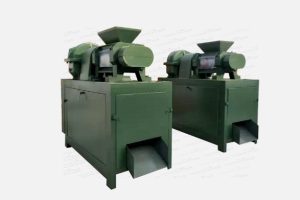
Benefits of Using Double Roller Granulators in Fertilizer Production
Double roller granulators offer multiple advantages:
- Efficiency: They provide high throughput with minimal waste, making the production process more streamlined.
- Energy Conservation: These machines consume less energy compared to those requiring wet granulation processes.
- Quality: The granulators ensure the production of high-density, uniform granules that promote even nutrient distribution in the field.
- Cost-Effectiveness: With low maintenance and operational costs, they are economically advantageous.
- Environmental Impact: The lack of water usage and wastewater production during the granulation process underscores its eco-friendly credentials.
Applications in the Fertilizer Industry
Double roller granulators are versatile, capable of processing various fertilizer formulations including NPK blends, urea, and ammonium sulfate. This adaptability allows manufacturers to meet diverse agricultural needs efficiently.
Maintenance and Operational Best Practices
Maintaining a double roller granulator is crucial for ensuring its longevity and operational efficiency. Regular checks and routine maintenance of the rollers and the die are essential. Operators should also be trained to handle common challenges such as material buildup or mechanical wear.
Conclusion
Double roller granulators play an indispensable role in the fertilizer industry, supporting sustainable agriculture by producing high-quality fertilizers more efficiently and environmentally friendly. Their importance will only grow as the global demand for food increases. If you want to learn more, you can come to my web.
.






